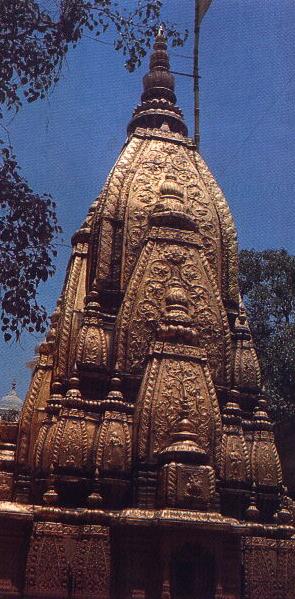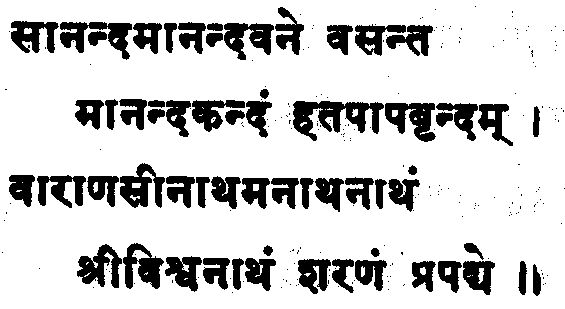Varanasi - Benares - Kaasi is
considered to be the holiest of all pilgrimage sites in India. It is considered home to Shiva
- Visweswara. Benares is also known as Kaasi because it is
beleived that Supreme brilliance shines there, and lights the way to salvation (Kas - to
shine). Varanasi is located between two rivers Varana and Asi,
and hence the name Varanasi.
This place is said to give the greatest delight to God
and hence the name Anandakanana; the five elements lie in this great
cremation ground as will all dead bodies at the time of the final deluge and hence the
name Mahasmasaanam.

Benares has been a pilgrimage center since time
immemorial. It is believed that the fifth head of Bhrama which clung to Shiva's palms came
unstuck only after he reached Varanasi. Varanasi has been mentioned in the Tamil
Tevaram hymns of the first millennium CE. Kasi is mentioned repeatedly in the
scriptures such as the Bhramanas, Upanishads, Kavyas and Puranas.
It is the oldest center of learning, and is vibrant with centuries of tradition.
Benares houses the Kaasi Visweswara (Viswanatha)
temple, enshrining one of the twelve Jyotirlingams
of Shiva. This temple was desecrated and rebuilt several times. The latest structure
dating back to the 18th century (thanks to the efforts of Rani Ahilyabhai Holkar)
is the center of attention of the millions of pilgrims who converge here, to perform an
abhishekam to the sacred Jyotirlingam, with water from the Ganges.
Benares is also considered to be one of the Shakti Peethas of India. It is believed that the left
hand of Sati fell at Varanasi, and that Annapurna or Visalakshi
represent the Shakti Peetham here.
Apart from these temples, there are five other sacred
spots in Benares. The Asi-Ganga sangamam, at Lolarka houses a temple to
the Sun God. The rivers Ganga and Varana converge at a spot where there is a shrine to Kesava.
The Panchaganga Ghat houses a temple to Bindu-Madhava.
It is believed that five rivers Kirana, Ganga, Yamuna, Saraswati and Dhuta-papa converge
here. The Dasaswamedha Ghat where it is believed that the ancient kings
performed the aswamedha sacrifice ten times and took a dip in the Ganga.
The last of the sacred spots is the Manikarnika
Ghat. Legend has it that Vishnu dug a pit with his chakra, and the sweat created during
his meditation filled the pit. Shiva shook his head and his jeweled earring fell into the
pit, hence the name Manikarnika. Tradition has it that those that die at Benares and get
cremated at the Manikarnika ghat, get liberated from the cycle of life and death.
Hyuen Tsang, the Chinese traveller
visited Varanasi in the 7th century. His travel accounts speak of the grandeur of the city
and of its temples. This writer describes a hundred feet high statue of Shiva
Maheshwara made of brass that adorned the city.
Several other temples and shrines adorn the city of
Benares. Virtually every block houses a shrine here. Mention must be made of the modern
shrine to Kaasi Viswanatha elsewhere in the city. Shivaratri in the month of Aquarius is a
season of great festivity at Benares.

See Also:
The Fifth Head of Bhrama
Abodes of Shiva
The Jyotirlingas of Shiva
